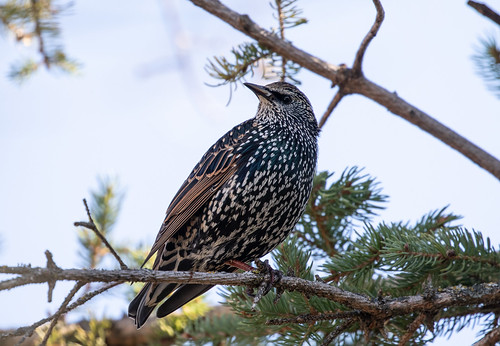Back in November 2019, when she was 10 years old, I made a new online friend living in northern Virginia named Amber Li. She and I have corresponded via email for a while, discovering that we share the same soft spot for birds—even invasive ones like European Starlings. But back on February 1, Amber wrote with a problem:
Hi! It has been quite a long time since my last email to you. Lately, starlings have been flocking to my feeding station in hordes. It seems as if they leave nothing for other birds such as bluebirds and titmice. I’m writing to ask if you get any starlings at your bird feeders. If so, how do you stop them from taking over and eating all the food? I’m getting slightly desperate because I really do want the other birds to get a chance to eat.
I’d been going several years without starlings here, but this summer, I happened to get a bunch, and they were here for a while this winter, though they seem to have moved elsewhere during the incredible cold spell we had. I suggested a few strategies she might try with regard to bird food. First, try not feeding sunflower hearts, but strictly sunflower seeds in the shell. Starlings have at least some trouble opening black-oil sunflower seeds, and a LOT of trouble opening the thick shells of striped sunflower. They also have trouble opening safflower. Nyjer seed is too small for them to deal with.
Amber wrote back:
I switched to another blend that’s not fully sunflower hearts, but more of a half sunflower heart half black oil sunflower seed with the shell. Sunflower seeds in the shell make a mess on the lawn (I learned that the hard way, I had to rake all the shells up!). Now the starlings can’t eat the seeds in the shell, which saves me more bird food, and the other birds can come in and eat the seeds with the shells.
The blend also has a lot of peanuts, tree nuts, and fruit. I add some mealworms as well. Also, whenever the starlings gathered in large flocks, I started chasing them from the feeder. After three days or so, they learned that gathering in large groups was not tolerated. The other birds soon figured out that I was only targeting the starlings. They trust me, and I’ve been able to stand a little more than a foot away from the feeder and get to observe birds such as bluebirds feeding right in front of my eyes.
Another thing, curiously, is that robins were attracted to my feeder for the mealworms and dried fruit. They were a real help because if a bold starling got too close, the robin would fight fiercely back for its place at the feeder. With the presence of robins, starlings have been avoiding the feeding station lately and have decreased in group size. Overall, I have a lot fewer starlings now, and new curiosities such as robins and the building trust between me and the birds are springing up. Thank you so much for the advice! It really helped. I’ve read those tactics before in books, but to hear it from a birder who has experience is very reassuring.
Not everyone can pay enough attention to their feeders to chase off problem birds consistently. As a writer, I spend much of the day near the window where Russ put my new tray feeder, and do wave off the starlings there. They can be such a problem, especially for bluebirds, flickers, Red-bellied Woodpeckers, and other cavity nesters, but I was kind of glad that they weren’t here at all during the coldest weather because as much as I want that feeder reserved for chickadees and nuthatches, I’d have had trouble sending any hungry creatures away during such desperate times. Finding an ethical balance between the wisest choices ecologically and morally is hard enough—when we throw compassion into the mix, things get even trickier. So I’m very glad that Amber Li has found a good answer in her own backyard.

